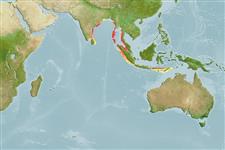>
Blenniiformes (Blennies) >
Blenniidae (Combtooth blennies) > Salariinae
Etymology: Ecsenius: Greek, exenios, -os, -on = uncontrolled, immoderate; lubbocki: Named for Roger Lubbock..
Environment: milieu / climate zone / depth range / distribution range
Ekologi
laut berasosiasi dengan karang; kisaran kedalaman 3 - 12 m (Ref. 90102). Tropical
Eastern Indian Ocean: known only from Phuket, Thailand.
Size / Weight / umur
Maturity: Lm ? range ? - ? cm
Max length : 4.0 cm TL jantan/; (Ref. 48636)
deskripsi pendek
Kunci identifiaksi (pengenalan) | Morfologi | Morfometrik
A generally dark species that is camouflaged when on the corals. It has a series of pale blotches along the body and a pair of black spots on the back of the head (Ref. 48636).
Adults solitary or in pairs on algae-encrusted coralline coastal reefs (Ref. 90102) and on shallow reef flats with mixed rubble and corals where usually found on boulder-shaped corals (Ref. 48636). Oviparous. Eggs are demersal and adhesive (Ref. 205), and are attached to the substrate via a filamentous, adhesive pad or pedestal (Ref. 94114). Larvae are planktonic, often found in shallow, coastal waters (Ref. 94114).
Oviparous, distinct pairing (Ref. 205).
Springer, V.G., 1988. The Indo-Pacific blenniid fish genus Ecsenius. Smithson. Contrib. Zool. (465):134 p. (Ref. 5296)
Status IUCN Red List (Ref. 130435)
ancaman kepada manusia
Harmless
penggunaan manusia
Alat, peralatan
laporan khas
muat turun XML
Sumber internet
Estimates based on models
Preferred temperature (Ref.
123201): 28.1 - 29.4, mean 28.8 °C (based on 279 cells).
Phylogenetic diversity index (Ref.
82804): PD
50 = 0.5000 [Uniqueness, from 0.5 = low to 2.0 = high].
Bayesian length-weight: a=0.00741 (0.00335 - 0.01640), b=3.02 (2.83 - 3.21), in cm total length, based on LWR estimates for this (Sub)family-body shape (Ref.
93245).
Trophic level (Ref.
69278): 2.0 ±0.00 se; based on food items.
Daya lenting (Ref.
120179): Tinggi, Waktu penggandaan populasi minimum kurang dari 15 bulan (Preliminary K or Fecundity.).
Fishing Vulnerability (Ref.
59153): Low vulnerability (10 of 100).
